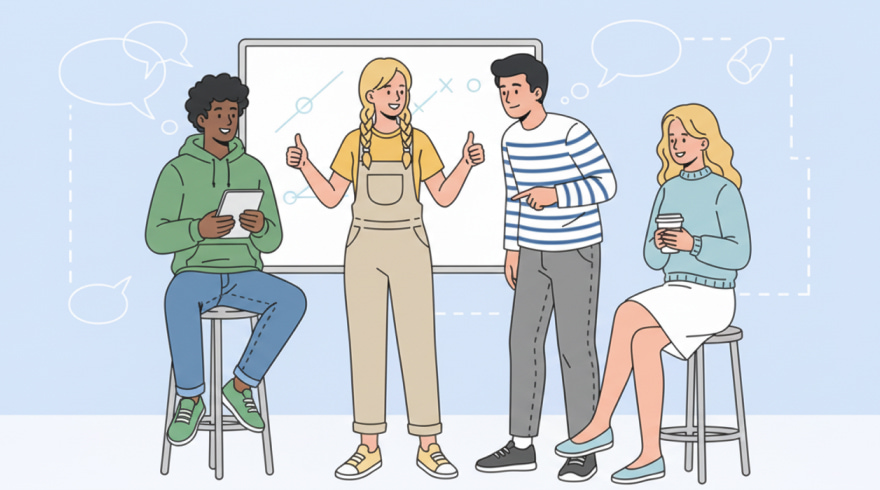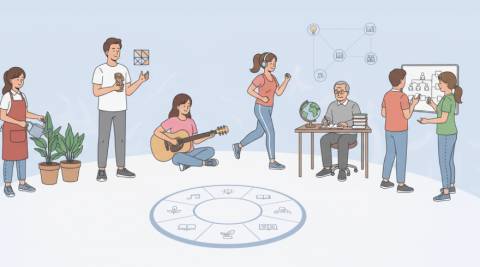A Practical Guide to Modern Intelligence Profiles and Self-Discovery

What Is a Multiple Intelligences Assessment?
People learn, solve problems, and express talent in distinct ways, and a well-built assessment can make those patterns visible. Rather than ranking individuals by a single score, this kind of measurement explores varied cognitive domains such as linguistic, logical, spatial, musical, bodily-kinesthetic, interpersonal, intrapersonal, and naturalistic strengths. When an instrument highlights your signature blend, it helps you understand how you prefer to process information, collaborate, and create. That clarity becomes a springboard for study strategies, career planning, and personal growth.
Across education and workplaces, interest in this approach continues to grow because it reframes ability as plural rather than singular. Many learners benefit when they see their talents reflected back through relatable examples and practical recommendations. As a result, a carefully designed multiple intelligences quiz can reduce test anxiety, promote self-efficacy, and spark motivation to try new methods that align with authentic preferences.
The idea originated in cognitive science and developmental psychology, then filtered into classrooms, coaching practices, and organizational development. What makes this perspective powerful is the invitation to notice how strengths interact in real tasks. A person might blend visual reasoning with interpersonal savvy in design meetings, or pair musical patterning with linguistic flair when crafting memorable speeches. By treating capacity as a mosaic, the assessment gives credit to abilities that traditional tests often overlook, and it encourages flexible, situational strategies for problem solving.
- Focus on patterns of strength rather than labels.
- Use insights to adapt study, work, and communication habits.
- Revisit results periodically as interests evolve over time.
How the Quiz Works and What It Measures
A robust assessment blends psychometric rigor with accessible language. Items typically ask how often you enjoy specific activities, which tasks feel effortless, or which learning formats keep you engaged. Responses run along Likert scales, allowing nuanced scoring that captures relative preferences. After completion, scores are normalized and compared across domains, producing a profile that highlights primary strengths, supporting strengths, and growth edges. The best instruments also provide qualitative prompts to help you connect numbers to real experiences.
Behind the scenes, reliability and validity matter. Internal consistency ensures that items targeting a domain truly cohere, while construct validity confirms that the domain itself reflects meaningful behavior outside the test. Clear reporting converts statistics into actionable suggestions, such as “use diagrams to plan” or “teach others to reinforce recall.” For many participants, a thoughtfully structured multiple intelligence quiz feels affirming, because it recognizes useful abilities that standard measures ignore.
Because context shapes performance, good reports include situational tips. A spatial thinker might thrive with whiteboards and mind maps, yet also benefit from peer discussion to refine ideas. An interpersonal problem-solver might lead collaboration, while leveraging checklists to keep details tight. This layered guidance helps people apply results immediately, and it turns raw scores into real habits that support learning, creativity, and productivity.
- Likert scale items balance nuance and clarity.
- Normed scores translate personal data into comparisons.
- Action steps bridge assessment and daily practice.
Benefits and Real-World Uses
Clarity about how you learn can transform routine challenges into solvable puzzles. When you understand your strongest modalities, you can choose study tools, collaboration styles, and creative workflows that match your natural inclinations. Educators can differentiate instruction, managers can design complementary teams, and creators can build repeatable systems that harness their best cognitive energy. These practical moves reduce friction, increase engagement, and unlock momentum in both school and work.
Individuals often want concrete direction for next steps, and a personalized report provides exactly that. For example, a linguistic leader might adopt retrieval practice through writing prompts, while a kinesthetic doer could switch to hands-on simulations. Many people who seek career alignment explore reflective inventories that make strengths visible in daily routines. In that spirit, an approachable what type of intelligence do i have quiz can double as a coaching conversation starter, guiding goal-setting conversations and portfolio choices.
Teams benefit when members share profiles and compare complementary talents. The visual planner might own timelines, the interpersonal facilitator might handle stakeholder communication, and the analytical partner might pressure-test assumptions. When each person leans into a role that matches their strengths, meetings become shorter, deliverables become sharper, and projects move faster. Over time, a shared language of strengths supports trust, constructive feedback, and resilient collaboration.
- Personalize learning plans and exam preparation.
- Match roles to strengths in group projects and teams.
- Choose career paths that fit cognitive preferences.
Intelligence Domains at a Glance
Understanding the landscape of abilities is easier when examples sit side by side. The following comparison offers a concise overview of domains, typical activities that energize each one, and everyday applications. Treat the list as a springboard for experimentation rather than a fixed identity statement. Your profile is a blend, and the richest outcomes come from combining strengths strategically for the task at hand.
Historical context also helps, because the plural view of ability grew from a challenge to narrow definitions of cognition. Educators still debate boundaries and labels, yet the classroom impact is unmistakable: more entry points for learning means more students feel competent. When you want a recognized framework to anchor your exploration, many turn to a thoughtfully designed Gardner multiple intelligences quiz for orientation before deeper practice and reflection.
| Domain | Energizing Activities | Everyday Applications |
|---|---|---|
| Linguistic | Writing, storytelling, debate | Persuasive emails, documentation, teaching |
| Logical-Analytical | Puzzles, modeling, experiments | Financial analysis, debugging, forecasting |
| Spatial-Visual | Sketching, mapping, prototyping | Design mockups, data visualization, architecture |
| Musical-Rhythmic | Composing, patterning, active listening | Audio branding, timing workflows, memorization |
| Bodily-Kinesthetic | Hands-on building, role-play, movement | Prototyping, stagecraft, athletics training |
| Interpersonal | Facilitation, negotiation, mentoring | Client relations, leadership, user research |
| Intrapersonal | Journaling, goal setting, reflection | Self-management, career planning, wellbeing |
| Naturalistic | Field observation, categorization, stewardship | Sustainability planning, gardening, lab work |
Use the table as a checklist for habit design. If a domain resonates, borrow two or three ideas and test them for a week. Keep what works, discard the rest, and iterate. Over time, the compounding effect of small, strength-aligned choices yields higher productivity, deeper comprehension, and calmer focus.
Guidance for Students, Teachers, and Teams
Different contexts call for different strategies, and tailoring your approach can accelerate progress. Students can map courses to strengths while also building stretch habits that reinforce weaker but necessary skills. Teachers can design varied entry points, short lectures, visuals, discussions, labs, so every learner finds traction. Managers can pair complementary team members and structure sprints around people’s best modes of thinking.
Classrooms are a prime setting for rapid gains, because even small adjustments compound over a semester. For instance, visual planners might convert chapter summaries into diagrams, and interpersonal learners can co-teach concepts to peers. Teachers can rotate roles in group work so each student practices multiple modalities without losing confidence. In academic advising sessions, a student-friendly multiple intelligence quiz for students often clarifies course selection, study routines, and extracurricular choices that build a coherent narrative.
On the job, teams benefit from pre-mortems and post-mortems framed by strengths. Before a project, assign responsibilities that align with natural preferences; after delivery, review what energized or drained each contributor. This rhythm preserves morale and reduces burnout. When people consistently work within their cognitive sweet spot, quality rises and timelines shrink, creating a virtuous cycle of trust and performance.
- Students: design study systems that match your strongest domains.
- Educators: differentiate instruction and feedback channels.
- Teams: allocate roles by strengths and revisit them each sprint.
How to Interpret Results and Take Action
Receiving a strengths profile is only the starting line. The next move is translating insight into daily practice by testing one change at a time. Start with a single course, project, or habit, and apply a tactic that resonates with your top domain. Track outcomes for a week, note energy levels, and capture what improved. This low-friction approach keeps momentum high while you dial in effective routines.
Because profiles reflect tendencies rather than fixed limits, you can target growth without losing the benefits of specialization. If logical analysis is already a superpower, protect time for deep work. If interpersonal facilitation lags, add brief check-ins to build fluency. For reflection prompts and habit ideas, a concise intelligence type quiz can act as a reference point you revisit whenever priorities shift across semesters or product cycles.
Remember to interpret scores relationally, not absolutely. A “lower” domain can still be decisive for specific tasks, just as a “higher” domain might need guardrails to avoid blind spots. By treating the profile as a living document, you give yourself permission to adapt as contexts evolve, which is the essence of sustainable performance.
- Adopt one tactic per week to avoid overload.
- Measure results with simple checklists or brief reflections.
- Refresh strategies when roles, classes, or goals change.
Tips for Taking the Assessment Effectively
Accurate results depend on honest, context-aware responses. Before you begin, choose a calm environment, silence notifications, and set aside ten uninterrupted minutes. Answer based on typical behavior, not on what you wish were true or what others expect. If items feel unfamiliar, think about similar situations and respond by analogy rather than guessing randomly.
It also helps to consider multiple contexts, school, work, and hobbies, because strengths often show up where you feel most engaged. After finishing, skim your report without judgment, then highlight advice you can apply this week. If you want a quick calibration tool to confirm patterns, many learners consult a straightforward what is my intelligence type quiz as a second data point before committing to new routines.
Finally, revisit your profile every few months. Projects, roles, and interests change, and your habits should change with them. Treat the assessment as a compass, not a cage, and keep experimenting until your everyday workflow feels both effective and energizing.
- Choose a quiet time and space to respond thoughtfully.
- Answer for typical behavior across real scenarios.
- Apply one or two recommendations immediately after finishing.
FAQ
How accurate are results from modern intelligence assessments?
Well-constructed tools demonstrate solid reliability and validity, especially when paired with reflective prompts that link scores to real behavior. For quick orientation before deeper exploration, some people use an approachable intelligence types quiz as an entry point, then confirm insights through projects and feedback.
Can I improve areas that score lower on my profile?
Absolutely, because the profile describes preferences rather than immutable limits. Many learners choose one target skill, add a weekly practice routine, and track progress over a month, often guided by a concise type of intelligence quiz that suggests specific, low-friction exercises.
Is this approach useful for career planning and job transitions?
Yes, because strengths map cleanly onto tasks you’ll face in real roles, from analysis and design to collaboration and teaching. When exploring options, candidates sometimes anchor their reflection with a compact multi intelligence quiz to identify roles that naturally fit their ways of thinking.
How should educators integrate insights into lesson design?
Teachers can create multiple entry points for each concept, brief talks, visuals, labs, and peer teaching, so every learner encounters a path that works. For quick diagnostics during planning meetings, some departments rely on a streamlined types of intelligence quiz to align strategies with student needs.
Do I need to retake the assessment regularly?
Retesting a few times each year can be helpful, especially after major schedule changes or new responsibilities. Periodic snapshots capture shifts in interest and context, which supports timely adjustments to study and work routines.
Latest News



